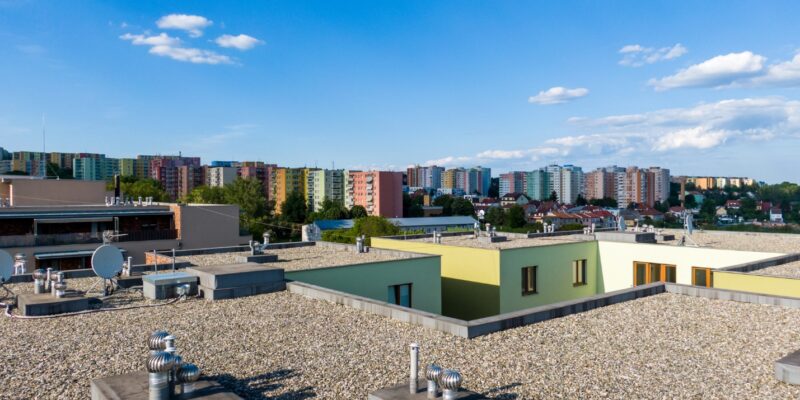Low-slope commercial buildings generally have flat roofs where gravel is laid on them. Roofing systems give protection to the property from the ultraviolet rays of the sun, hailstorms, pouring rains, and other elements in the environment.
It’s just right that the owners should do their best when it comes to prolonging the lifespan of their roofs, especially when they are in the areas that experience a lot of seasonal changes each year.
One popular addition is the built-up gravel and tar type that’s made from alternating layers of asphalt, fiberglass, and felt. See more about the reason why homeowners prefer gravel on this page here.
Also, it’s safer for the materials, and the ultimate goal is to have a long-lasting system that’s enhanced by a coat of asphalt to firmly hold all the other parts.
Why Do Roofs Have Gravel On Them?
Weatherproofing is one of the more common reasons why built-up roofs are getting a layer of gravel on them. It’s going to stay for a very long time and can prevent cracks that can cause leaks. Failure is also minimized because the material is going to prevent blistering, and ballasted roofs can keep the entire home cool.
Minimize your utility bill payments each month by decreasing the pressure on your air conditioner to cool the entire area. Ballasted systems are, of course, a good choice for both residential and commercial building owners but know that they have their own disadvantages. Precise measurements and weight should be observed so the entire structure can hold the roof in place and there’s no compromise with the structural integrity of the entire foundation.
Weights should be around 10 to 25 pounds per square foot depending on the structures around them, so it’s best to work with a professional to know about these. Detection of leaks may be complex because the owners might not exactly know for sure where they are coming from. Fortunately, with a lot of technology being utilized, like thermal imaging, drone shots, and video capture, it’s now possible to know the problematic areas in your roof regardless of the materials that they are made of.
Built-up roofing can also offer a wide range of advantages because the gravel is going to provide a firm grip for foot traffic. It’s ideal for people who are planning to party on the deck, and this will make the repairs and maintenance easier for the experts. Leaves, debris, and dirt can also be easily removed because they can’t easily stick to gravel.
Single-ply systems may use the ballast types, where it’s going to play a role in reducing the weight of the entire roofing material so it won’t be too heavy on the rafters. Replacing gravel with propylene diene monomer, polyolefin chemical compounds, and PVC can be an option, but these types are not self-adhering. This means that when there are high winds present brought by storms, they need weights on them to keep them from flying away.
Do You Really Need to Add Gravel?
Depending on your situation, the expert contractors may recommend adding gravel as loading coats when you want a secure system. It’s going to anchor the materials and protect you from hurricanes and other hazards.
The last layers of the gravel tend to perform well with the built-up design, and they can be repaired by professionals. Lasting for over 20 years or more, they can be a good waterproofing option and an excellent investment because the aggregate layers on top can be resistant to fire. Know that DIY is not always the best route for this type of expensive project, so it’s best to consult professional roofers about them if you’re in doubt.
Roof Insulating Properties
Preventing heat, cool air, and the other elements outside the property from penetrating the interior can strengthen the thermal stability of a home. It’s also going to reduce noise, and this is why getting a roof is also tied to thermal insulation that’s going to reduce energy loss overall.
Aside from gravel, there’s matting or blanket insulation that’s available in rafters. They are placed between the joists and are held in place through timber battens. Find the ones made from mineral or glass wool, but there are others from natural fibers.
Foam boards are great alternatives to the more expensive fiberglass, and they are made of polyurethane or other plastic materials. Contractors generally find them easy to work with, and they can resist moisture without any problems.
Reflecting the radiation from the sun and preventing the transfer from one side to another can also be possible with radiant barriers. It’s attached to an oriented strand board or bubble insulation, and it can add comfort to the home.
Selecting the Right Contractor

Companies might recommend the standard way of installing roofs that are common in your area. However, why not add the gravel into the mix when you want to increase the insulation?
Get more information from the contractors who can walk you through the process. By checking https://www.ktmroofingboston.com/, you’ll have an idea whether a built-up type is right for your property or you’re better off with something else. Remember that these additions to your home are expensive, and this is why you should be very careful about the company that you’re hiring.
Check their reviews on various websites and see what others have experienced on them in the past year. Narrow down your choices to those who can provide you with a wide array of services in your county, and they should have a physical office address where you can visit and check on their portfolio. Most importantly, they should be insured and licensed so you know that you won’t be liable for accidents that may happen on-site.
Installation of gravel is complicated, and there might be issues with logistics and working on higher places to consider. Make sure that you’re working with professionals who can solve some of the problems that they might encounter along the way and provide you with a detailed cost for their labor and the materials that they are going to use.
Talk to at least three companies before choosing one and see what the market prices are. Compare and negotiate if necessary, and always look for high-quality work over pricing.













Comments